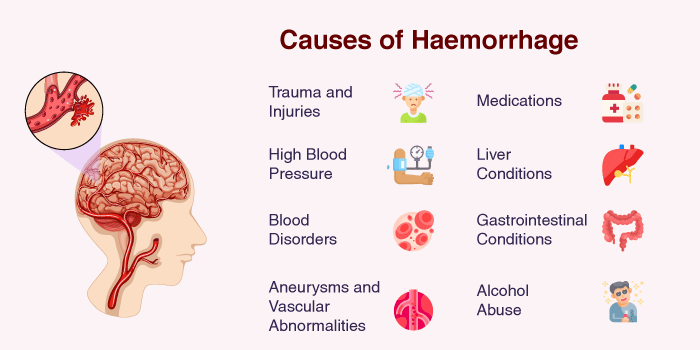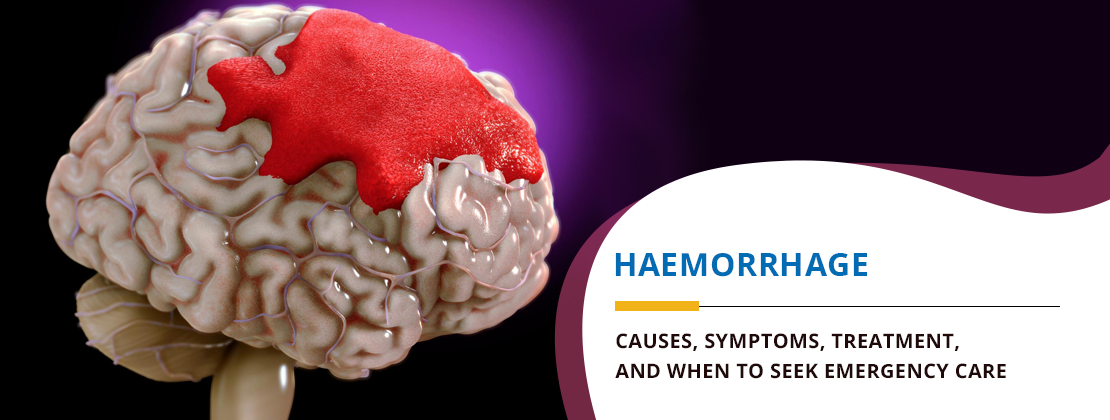What is a Haemorrhage?
Haemorrhage is a term used to describe too much blood loss due to injury or bursting of blood vessels; this bleeding may be inside or outside the body, depending on whether it remains concealed or can be seen.
Although minor bleeding is not dangerous, massive bleeding can cause problems such as organ failure, coma, or even death. Brain haemorrhage, in particular, requires immediate medical attention as it can cause neurological damage.
The seriousness of a haemorrhage is determined by different factors, such as the quantity of blood lost, where the bleeding is, and how fast it happens.
The body can make up for a little blood loss. However, too much bleeding may lead to hypovolemic shock, a dangerous illness characterised by organ failure as a result of inadequate circulation.
What are the Different Types of Haemorrhage?
Haemorrhages are classified based on their location and severity. The primary types include:
- Internal Haemorrhage: Blood may flow internally following injury or due to certain illnesses like aneurysms.
- External Haemorrhage: Blood can be seen coming out of the body through cuts, injuries, or operations.
- Brain Haemorrhage: It is a severe form of internal bleeding that is commonly associated with stroke, hypertension, or trauma.
- Gastrointestinal (GI) Haemorrhage: There is bleeding in the digestive system, which may result from ulcers, infections, or some drugs.
- Postpartum Haemorrhage: This refers to the blood loss that occurs immediately after childbirth in mothers, and it may even cause death if not managed on time.
- Pulmonary Haemorrhage: Blood coming out of the lungs as a result of infections, injuries, or diseases like tuberculosis.
- Subarachnoid Haemorrhage: A particular form of brain haemorrhage that happens beneath the brain and its delicate envelopes, usually causing abrupt, intense head pain.
Also Read: Brain Aneurysm, Its Symptoms, Diagnosis, and Treatment
Symptoms of Haemorrhage

The symptoms of haemorrhage depend on its location and severity. Common signs of haemorrhage include:
- Internal Haemorrhage
- Dizziness or fainting
- Rapid heartbeat
- Low blood pressure
- Swelling or pain in the affected areas
- Pale or clammy skin
- Cold extremities due to poor circulation
- External Haemorrhage
- Visible bleeding from wounds
- Blood in urine, stool, or vomit
- Persistent bleeding that does not stop with pressure
- Weakness or fatigue due to blood loss
- Brain Haemorrhage
- Sudden, severe headache
- Vision disturbances
- Weakness or numbness in limbs
- Difficulty speaking or confusion
- Loss of consciousness
- Seizures or difficulty maintaining balance
Causes of Haemorrhage

Several factors can contribute to haemorrhages, including:
- Trauma and Injuries: The bursting of blood vessels may occur due to accidents, falls, or issues arising from an operation.
- High Blood Pressure: Continually high blood pressure makes blood vessels weaker and increases the risk of brain haemorrhage.
- Blood Disorders: Hemophilia and leukemia are illnesses that make blood not clot properly, thus causing too much bleeding.
- Aneurysms and Vascular Abnormalities: If blood vessels are weak or have not developed well, they may break without any warning signs.
- Medications: Anticoagulants may heighten the chances of bleeding.
- Liver Conditions: Clotting depends on the liver function, which is disturbed in hepatopathies, causing hypoprothrombinemia.
- Gastrointestinal Conditions: Ulcers, infections, and cancers can cause bleeding in the digestive tract.
- Alcohol Abuse: Chronic alcohol consumption can weaken blood vessels and impair clotting, making individuals more susceptible to haemorrhages.
Diagnosis and Tests for Haemorrhage
Early and accurate diagnosis is crucial in managing haemorrhages effectively. Those having signs or symptoms of haemorrhages should visit a good multispeciality hospital in India for diagnosis and appropriate treatment.
- Physical Examination: It involves evaluating symptoms, checking for external bleeding, and assessing vital signs.
- Blood tests: They involve checking blood clotting ability, platelet count, and haemoglobin levels.
- Imaging Tests:
- CT scan or MRI: These imaging methods help specialists locate the site of the brain haemorrhage and internal bleeding and determine the severity.
- Ultrasound: It helps visualise internal bleeding, especially in pregnant women.
- Endoscopy/colonoscopy: It examines the digestive tract for GI bleeding sources.
- Angiography: This is a type of imaging test that uses contrast dye to detect abnormalities in blood vessels, particularly useful in diagnosing aneurysms.
Effective Management and Haemorrhage Treatment Options

The treatment of haemorrhage depends on its severity and underlying cause. Common approaches include:
1. First Aid for External Haemorrhage:
-
- Apply direct pressure to the wound to stop bleeding.
- Elevate the affected area if possible.
- Use a clean cloth or bandage to prevent infection.
- Apply a tourniquet only in extreme cases where bleeding is uncontrollable.
2. Medical Treatments:
- Medications:
- Blood transfusions are recommended for severe blood loss.
- Vitamin K or clotting factor replacement for bleeding disorders.
- Reversal agents for anticoagulant-induced bleeding.
2. Surgical Interventions:
- Craniotomy or Burr Hole Surgery: This procedure removes blood clots and relieves pressure caused by brain haemorrhages.
- Endovascular Coiling or Clipping: This is a minimally invasive procedure recommended to prevent aneurysms from bursting or causing internal bleeding.
- Cauterisation or Endoscopic Clipping: This is a procedure that involves sealing blood vessels or closing wounds to control bleeding in the GI tract.
- Laparotomy: This is a surgical procedure that directly accesses the abdominal cavity to locate and treat internal bleeding.
3.Lifestyle and Preventive Measures:
- To control high blood pressure to prevent strokes and brain haemorrhage.
- To avoid blood-thinning medications unless prescribed.
- To undergo regular medical checkups to detect and manage conditions early.
- To maintain a healthy diet and stay hydrated to support blood health.
Also Read: Neurosurgery in Brain Stroke Treatment by HCG Hospitals
What are the Signs of a Haemorrhage Medical Emergency?
Certain signs of haemorrhage indicate the need for immediate medical attention. Seek emergency care if you experience:
- Uncontrolled bleeding that does not stop with pressure
- Sudden severe headache with vision problems or confusion
- Fainting, dizziness, or a significant drop in blood pressure
- Blood in vomit, urine, or stool
- Difficulty breathing or extreme weakness
- Seizures, loss of coordination, or unconsciousness
Delaying medical intervention in such cases can be life-threatening, and immediate treatment in a hospital setting is essential. HCG Hospitals is a leading multispeciality hospital in India that has an experienced team of specialists to manage haemorrhages and their complications.
Conclusion
Timely diagnosis and treatment are crucial for the effective management of haemorrhages. Regardless of whether it is due to injury, hypertension, or other illnesses, urgent medical treatment can avert fatal problems. Knowing the signs of haemorrhage and when to seek emergency care can prevent deaths. Call an ambulance without delay if you or someone you know shows any signs of bleeding. Taking precautions such as having a healthy lifestyle and going for medical tests often can lower the chances of haemorrhages in the brain and improve overall well-being.



